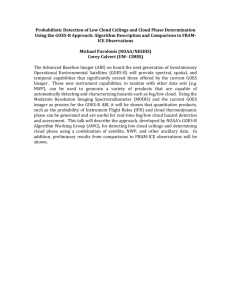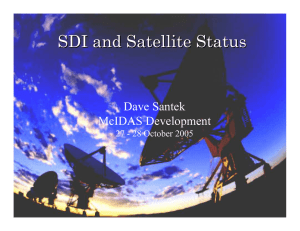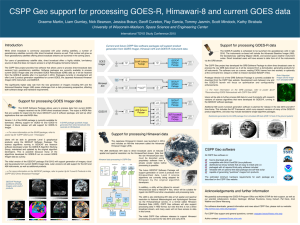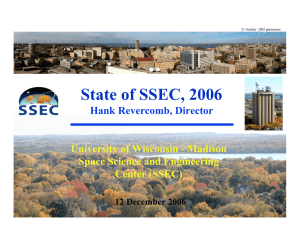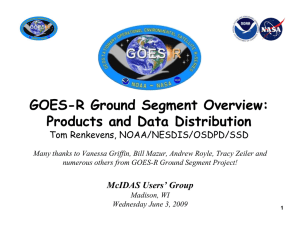SDI (Satellite Data Ingestor) 2015 McIDAS Users Group Meeting June 8, 2015
advertisement
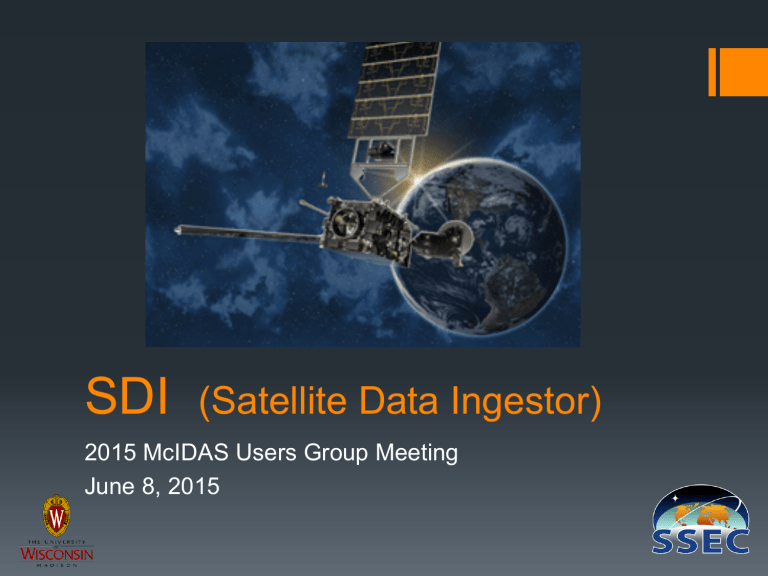
SDI (Satellite Data Ingestor) 2015 McIDAS Users Group Meeting June 8, 2015 Overview SDI 104 Hardware configuration Software configuration Satellites signals Next generation SDI Hardware Configuration Software configuration Satellites signals SDI 104 Hardware Configuration PC/104-Plus LittleBoard 735 1 GHz CPU Disk: 160 Gbyte IDE Boot from compact flash Ethernet: Up to 1G/s Connectors for monitor and keyboard Mounted in 2U rack box Hardware Configuration Data rates tested up to 40 Mbits/s Connectors: – D15P – BNC Configuration: – Single ended (TTL) – RS422 (differential) Data types – NRZ-L, NRZ-M, NRZ-S – Jumper configurable Software Configuration Knoppix 6.7.1 (Linux 3.0.41) Up-to-date security Compatible with old binaries Upgrade to Knoppix for older SDI-104 systems running DSL as needed Can be configured as a standalone ingestor/server, or write data to an external disk (via NFS, for example) Event Notification Notifications are dependent on signal type: – – Image start (not for POES) Image end (not for GVAR Imager) Three types of notifications: – – – Send an email Write notification to a file (log messages) Run a program or script SDI-104 Status for Current Satellites GVAR: up-to-date for entire series MTSAT: up-to-date for both satellites - May want to add swap space if running DSL (noisy data) POES AVHRR: Up-to-date for all satellites Unable to test direct reception, although a system is running at NWS Honolulu (Original) SDI Sunset The Original SSEC SDI was sunset on 31 December 2013 We are not able to provide nor recommend hardware components if these would fail The operating system used is an unsupported version of Solaris, which has been lacking security updates for several years. SDI … the next generation Introducing the SDI-SE SDI-SE Hardware Configuration* Dell PowerEdge R430 servers 12 core, 2.5 GHz Intel Xeon Processor 64 GB Ram 6 1-TB disks in RAID-6 10 Gb Ethernet and 1 GB Ethernet No more clock and data Everything over ethernet (no SSEC designed hardware components) *preliminary SDI-SE Software Configuration* CentOS 6.x Software and security updates via yum Repository at UW SSEC McIDAS-X ADDE servers CSPP-GEO ingest software RabbitMQ event notification *preliminary SDI-SE Data Access* ADDE FTP *preliminary SDI-SE Event Notification* RabbitMQ Built in exchange server Start and End Events No more email events Remote workstations will be able to connect to the Exchange server and receive desired events May update SDI-104 to use RabbitMQ in the future *preliminary SDI-SE Supported Satellites * GOES-R series Ingest handled by CSPP GEO Instruments ABI (Advanced Baseline Imager) Follow/tracking GLM (Geostationary Lightning Mapper) MAG (Magnetometer) SEISS (Space Environment In-Situ Suite) SUVI (Solar Ultraviolet Imager) EXIS (Extreme Ultraviolet and X-ray Irradiance Sensors) No Level-2 processing on the SDI-SE HimawariCast (under consideration) GVAR (under consideration) *preliminary What is CSPP – GEO? Community Satellite Processing Package for Geostationary Data NOAA sponsored project being developed at UW SSEC The software will be capable of processing GOES Rebroadcast (GRB) data received from the next-generation GOES-R satellite. Level 2 Advanced Baseline Imager (ABI) products will be generated by state-of-the-art science algorithms developed under the GOES-R Algorithm Working Group project. Software is freely available and is distributed as selfcontained binary packages built for 64-bit Linux systems. CSPP – GEO initial product suite Cloud mask Cloud phase Cloud type Cloud top height Cloud top temperature Cloud top pressure Cloud 11 µm emissivity Cloud visible optical depth Cloud effective radius Cloud liquid water path Cloud ice water path Probability of Marginal Visual Flight Rules (MVFR) Probability of Instrument Flight Rules (IFR) Probability of Low Instrument Flight Rules (LIFR) Low cloud geometric thickness End
